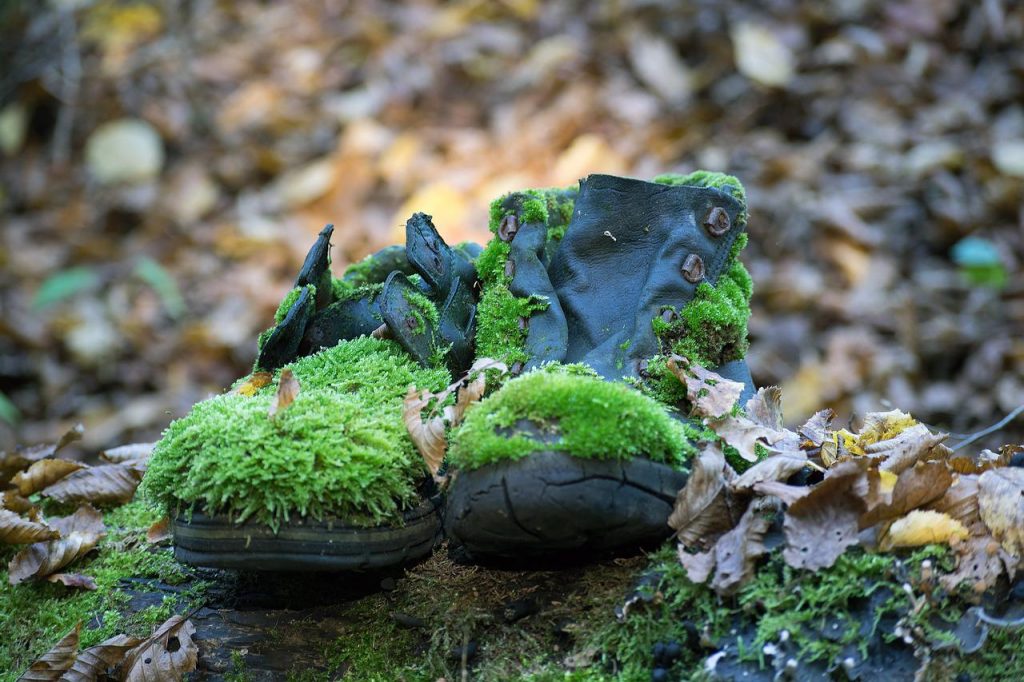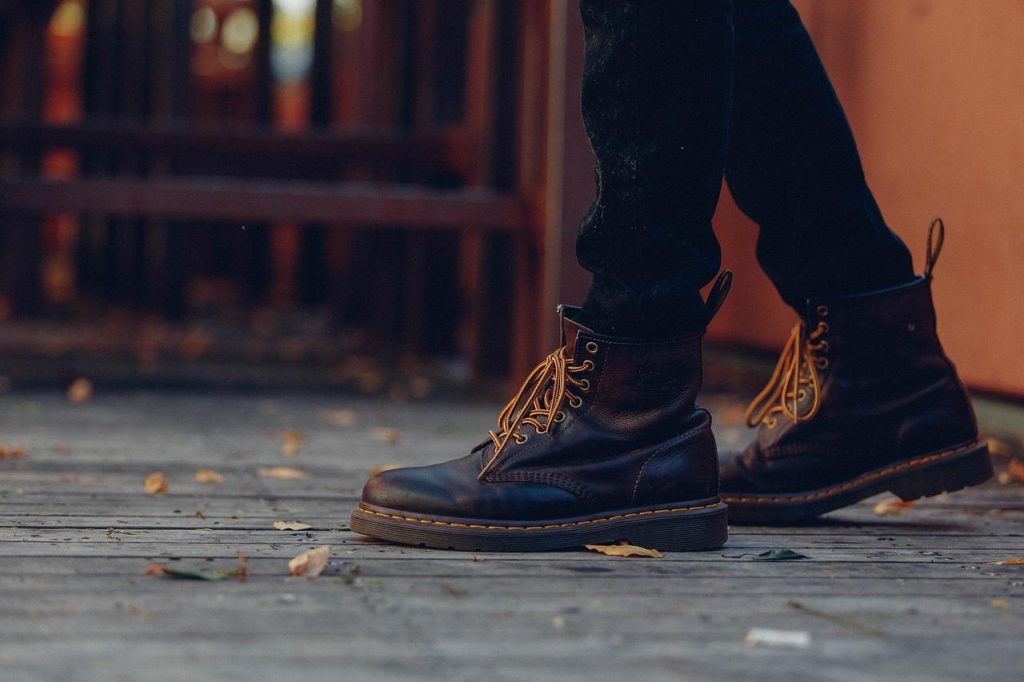By Tess DiNapoli
Revised and updated by Brett Stadelmann
Let’s face it, shoes are a necessity of life. But more and more shoes get thrown out every year. The global problem of shoe waste has reached a point where we cannot ignore it anymore.
Experts say that the global footwear industry will be worth USD 568.54 billion by 2031. Advertisers convince consumers to buy more, and this increases the demand for production. Every year, more than 20 billion shoes are manufactured.
The manufacturing process releases large amounts of carbon dioxide. It is responsible for 1.4% of GHG emissions in the world. Your pair of sneakers generates 30 pounds of CO2 emissions, keeping a 100-watt light bulb on for a week.
Plus, shoes are made of synthetic materials that take years to biodegrade. We may not see their impact on the environment right away. From their moment of production until their end of life, they harm the planet. Shoes release toxic chemicals that negatively affect our health. They are also bad for our planet and the health of wildlife.
Every year in the US, people throw away over 300 million pairs of shoes, 95% of which wind up in landfills. But what happens after that, and what can we do to reduce these damaging effects? That is what we are going to explore today.
NNormal Shoe Durability Study
Using a sample of 511 runners, NNormal has subjected its Kjerag trail running shoes and has concluded that they can last up to 1.350 Km before being completely worn out.
This data is especially important as the sports equipment brand claims durability as the main factor when calculating the environmental impact of trail running shoes.
The Study
NNormal has conducted a study based on a sample of 511 runners of all levels, and has been able to verify that their Kjerag should last 1,350 Km before being completely worn out or before concluding their lifecycle.
To reach this conclusion, the runners who participated in the study provided data related to their weight, the kilometers covered with their Kjerag, the terrain on which they used them, and the level of wear of their shoes, which was governed by the NNormal Durability Scale. With this system, NNormal has been able to link the wear of each person’s shoes with the kilometers covered and, consequently, predict the average lifespan of the Kjerag.
The study concludes also that more than 65.16% of the runners have used the Kjerag for more than 1,000 kilometers.
Learn more about the study here.
For further reading, see our interview with award-winning Alaskan artist, filmmaker, climate activist and NNormal Ambassador Max Romey, exploring the health and environmental consequences of the global shoe industry and sustainable solutions for the future:
An Interview: Max Romey, Ocean Plastics, and a Circular Footwear Industry
Check out our other complete guides:
- Sustainable Fashion: Organizations, Certifications, Fabrics
- Sustainable Shoes: A Complete Guide and 30 Ethical Brands
- Vegan Shoe Brands: The Complete Guide to Cruelty-Free Shoes

What Happens to Shoes After We Throw Them Away?
Shoe waste ends up in landfills. It contaminates the environment by emitting chemicals into the soil and groundwater. Dyes release harmful heavy metals while soles decompose into chemicals like polyurethane.
Burning shoes is not a good solution, either. It releases more chemicals into the atmosphere, which contributes to air pollution. These chemicals are undeniable health hazards that enter our bodies. The health costs of pollution are disastrous, cancer being one of them.
How Much Waste Is Created By the Standard Manufacture of Shoes?
Shoes are not harmful to the environment only when you throw them away. A large part of their impact comes from manufacturing and acquiring raw materials. Manufacturers use fossil fuels or coal to power up their factories. Burning these fuels creates carbon dioxide and other greenhouse gases. These gases then enter the atmosphere.
Transportation is another air-polluting factor in shoe production. Most companies hire cheap sources of labor in developing nations. After production, they need to transport the shoes using ships and planes. Plus, they need trucks to deliver their products to retailers.
Factories dispose of their waste in ordinary dumps or release them into sewers. These unethical practices release dyes, adhesives, and preserving chemicals into the environment. Let’s look at some of the Frequently Asked Questions about shoe waste to learn more.
Frequently Asked Questions
How Are Shoes Disposed Of?
Shoes are disposed of in ways that are damaging to the environment. The most common ways to dispose of shoes are to throw them in landfills and incinerate them. These are easy ways of releasing toxic chemicals into the surrounding environment.
Can Footwear Be Recycled?
The way companies produce shoes at the moment doesn’t take their recycling into account. By using metal parts in their shoes, they make recycling very difficult. The shock-absorbent soles they put in trainers can stay in landfills for 1,000 years! So it’s not shocking that only a small amount of shoes are recycled.
Are Shoes Biodegradable?
Most shoes made with traditional methods have materials that cannot biodegrade in a short period of time. They’re made with plastics and glues that don’t break down easily.
How Long Does a Shoe Take to Biodegrade?
It might take anywhere from 25 to 1,000 years for a shoe to biodegrade. Natural materials take 25-80 years, and leather shoes take 25-40 years to disintegrate. Rubber shoes can take 50-80 years to break down. Synthetic materials made from plastics take much longer, going up to 1,000 years to decompose.
Why Are Shoes Bad for the Environment, and How Polluting Are They?

A 2013 study at MIT found that a pair of running shoes produces 13.6 kilograms of carbon dioxide emissions. Running shoes and sneakers have to withstand more force than regular shoes. To account for this, they are made from petroleum-derived plastic materials. These materials account for 1.4% of global greenhouse emissions. The cotton in sneakers is also harmful because cotton production requires chemicals.
Leather shoes are also polluting since they are related to raising cattle. Raising cattle leads to more greenhouse gases and deforestation. The chemicals used to toughen the materials have adverse effects on our planet’s health.
When Should You Throw Away Your Shoes?
Most people need to replace their shoes every 8-12 months. Running shoes wear out faster, and you need to replace them after 300-500 miles of running. Although, these all depend on you, your body weight, and the shoes’ material.
Replace your everyday shoes if:
- the heels are scuffed
- the midsoles are wrinkled
- the back edge of the heels has turned into a sharp angle.
What Can You Do With Old Shoes?
Throwing out your shoes is not your only option when they get worn out. You can get your old shoes resoled at your local cobbler. Another option is to recycle their different parts and make something new. Another option is to donate them. What seems worn out to you might be of use to another person. If your shoes are too worn for any of these solutions, you can throw them out.
What Is Being Done to Combat the Global Shoe Waste Problem?
Better Manufacturing Practices
Many shoe manufacturers are changing their practices to combat the shoe waste problem. They know that finding innovative ways to reduce emissions can help the environment. It can also result in a better brand image. They are striving to create sustainable practices and better working conditions. Companies are also interested in ethical material sourcing and better waste disposal.
Some are even using 3D printers to make their products. Many retailers are also transitioning to zero waste companies to help the situation. But we as consumers have to meet these companies halfway for the most effective results.
Eco-Friendly Sُhoes
Brands are looking into sustainable practices to conserve energy and save natural resources. They strive to develop sustainable designs, production methods, and distribution channels. The effect on the environment should be reduced while being safe for the consumers.
Collaboration is needed to make changes to the entire manufacturing process. Seventy percent of footwear companies are working to be more sustainable. They have turned to less harmful chemicals and materials. collaboration and making changes to the entire shoe manufacturing process.
Some of these other materials are more expensive. Research could help find less expensive alternative materials. Technological advancements in recycling existing materials are another promising step toward sustainability.
Sustainable Programs
There are companies that are taking innovative steps to fight shoe waste pollution. Nike has a recycling program that takes old shoes and turns them into gym floors and tennis courts. Gucci is another world-renowned brand taking part in sustainability. Currently, it is working on a line of shoes made from bioplastic.
Smaller companies in Europe are also removing chemicals and materials from their products. There is hope to eradicate the shoe waste problem with so many companies on board. But none of this is possible without your cooperation.
What Can You Do to Fight Shoe Waste Pollution?

Resell and Recycle
Reselling and recycling your used shoes is the easiest way to help this situation. You can resell your shoes to keep them away from landfills while making some money. If you are feeling charitable, you can donate them instead. Since thrifting has become so popular, your shoes have a good chance of finding a new home.
If your shoes are too worn out, you can recycle them. Many companies have recycling programs for old shoes. As we mentioned before, Nike is one of them. The Reuse-A-Shoe program turns your old sneakers into football fields and playgrounds.
Sustainable Shoes
You can join the sustainability trend by turning to eco-friendly shoes. These are sustainable sneakers that are made from responsibly sourced materials. They are biodegradable as well as being either vegan or recycled. New brands are developing sustainable shoes all the time, giving you more options.
Educate Others
You can help reduce the global shoe waste problem by educating your friends and family. Learn as much as you can on the matter and encourage others to shift to sustainable alternatives with you.
Do Your Part in Saving the Planet
The power to change the environment is in your hands. So stop buying harmful shoes and choose eco-friendly alternatives instead. That is the only way to stay safe from harmful chemicals and get through this global problem.
About the Author
Tess DiNapoli is an artist, freelance writer, and content strategist. She has a passion for yoga and often writes about health and wellness, but also enjoys covering the fashion industry and world of fitness.